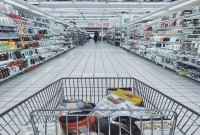- Home
- Business Processes
- Industry Knowledge
- Aerospace Industry
- Automotive Industry
- Banking Domain
- BFSI Industry
- Consumer/ FMCG Industry
- Chemicals Industry
- Engineering & Construction
- Energy Industry
- Education Domain
- Finance Domain
- Hospitality Domain
- Healthcare Industry
- Insurance Domain
- Retail Industry
- Travel and Tourism Domain
- Telecom Industry
- Leadership Skills
- eLearning
- Home
- Domain Knowledge
- Consumer/ FMCG Industry
- Retail Industry: Current Challenges
Retail Industry: Current Challenges
Today consumers are choosing multichannel buying experiences and expect that to be a seamless experience. To attract customer loyalty, retailers need to provide an experience that stands out from others. Learn the challenges faced by the retail sector today. Multi-channel sale avenues, changing consumer behavior, technological advances, rising competition, rising frauds, and supply chain management are some of them that require immediate attention.
Consumers today have changed the way they interact with businesses.
Given below are some challenges that are faced by the retail industry today:
1. Multichannel Availability:
The means by which consumers purchase products, services, or offerings have undergone vast changes during this decade. The consumer has adapted to multiple channels and they move easily across channels to search for products, decide on the best product through discussions or reviews, search for the best prices and promotions on the net, finalize a store/web-store and finally make a purchase. Retailers need to understand this need for changing behavior and enable themselves to service the customers through various channels while presenting an integrated view of the business.
2. Changing Consumer Behavior:
In today’s world product differentiation is minimal and consumers are becoming more and more price sensitive. They look for differentiation and consistent experience when they move across different channels to buy the same product. Retailers succeed where they are able to offer a personalized experience.
3. New Technology Innovations:
A proper framework is needed to understand all the facets of operations and technology which need to be deployed to deliver on the expectations. With the advent of the internet, retailers can create online stores that are open 24 hours a day, 7 days a week. Customers can shop from the comfort of their own homes, searching for products, and comparing prices of retailers around the world. The Internet has increased both opportunities and competition within the retail industry.
4. Rising Competition:
The competition between players in the industry is increasing day by day as the products, items, or services that were only available and sold at only one type of store but are now available at many different types of stores. The four traditional areas of competition between retailers are price, variety, assortment, and convenience. Prices can change frequently due to sales and promotions. Product variety refers to the number of categories of products carried by a retailer. Assortment refers to the number of items a retailer carries within a certain category. Convenience refers to where a store is located.
5. Availability of Skilled Workforce:
The industry is facing a shortage of middle management level professionals. Major retailers are hiring aggressively from the similar and smaller organizations by offering better packages. They are creating various levels of management and hiring on a spree. Some of the areas such as technology, supply chain, distribution, logistics, marketing, product development, and research are becoming very critical for the success of the organizations. All of these would lead to the recruitment of highly professional people who specialize in these fields. The sector is likely to produce 5 million jobs in the coming 3 years in the developing nations alone.
6. Optimization of Supply Chain Management:
The retail scenario is characterized by logistical challenges, constant changes in consumer preferences, and the evolution of new retail formats. All this increases the challenges faced by the industry. Various strategies are to be implemented to improve core business processes, such as logistics, innovation, transparency, distribution and inventory, management of point sale (POS) data. Retail majors are under serious pressure to improve their supply chain systems and distribution channels and reach the levels of quality and service desired by the consumers. Warehouse facilities and timely distribution are other areas of challenge.
7. Preventing Frauds in Retail:
It is one of the primary challenges retail companies would have to face. Frauds, including vendor frauds, thefts, shoplifting, and inaccuracy in supervision and administration are the challenges that are difficult to handle. Retailers have to deal with customer theft, employee theft, and supply chain theft. This is so even after the use of security techniques, such as CCTVs and POS systems. As the size of the sector would increase, the number of thefts, frauds, discrepancies, etc. in the system would also increase.
8. Improving Infrastructure & Logistics:
Lack of proper infrastructure and distribution channels in any country results in inefficient processes. A non-efficient distribution channel poses problems for retailers as it is very difficult to handle and can result in huge losses. Urbanization and globalization are compelling companies to develop Infrastructure facilities. Transportation, including railway systems, has to be more efficient. Highways have to meet global standards. Airport capacities and power supply have to be enhanced.
9. Maintaining Loyal Customers:
To sustain customer loyalties, retailers must be able to provide their customers, right products, at the right time and at the right location. This can lead to higher revenue growth, which can enable the retailer to obtain better purchasing conditions and pass the savings on to customers, leading to more profitability and growth.
10. Inventory Management & Optimization:
Inventory management refers to the processes retailers use to control ordering, shipping, receiving, storage, tracking, and delivery to customers. Poor maintenance of inventory means either having too much of one product or having too many slow-moving products that result in space constraints for other fast-moving profitable goods. Requirements of an inventory management system include capabilities for tracking inventory, evaluating sales, analyzing and comparing products, and collecting sales data for individual stores.
Some other challenges faced by the industry are media explosion, corporatization of retail, the new breed of entrepreneurs, and entry of foreign retailers. On the other hand, the rising income of consumers across the globe is also creating huge opportunities for this industry.
Related Links
You May Also Like
-
Retail Industry – Drivers & Dynamics
To succeed in the retail sector, retailers must offer compelling value propositions and be responsive to market dynamics. The continued rise of e-commerce has altered the dynamics of the retail industry in such a way that has forced retailers to drastically reallocate their resources to multi-channel strategies. This article focuses on retail industry drivers and dynamics that provide the reader with a basic understanding of the factors that influence this trade. Understand the business drivers and dynamics of retail industry
-
Retail Industry: Key Performance Metrics
You cannot manage what you do not measure and cannot measure what you do not define. Learn the key performance metrics for the retail industry like Sales per square foot, Gross margins return on investment, Average transaction value, Customer retention, Conversion rate, Foot traffic, and digital traffic and Inventory turnover, etc. These metrics are used across the globe by key industry players to track and improve their performance.
-
Retail Industry: Revenue Model
Understand the traditional retail revenue model and, what are the variations in different revenue models adopted by key players in the retail industry. Analyze the pros and cons of various models. The most common and most profitable revenue model is that of the traditional retailer. The traditional retailer profits by selling products and services directly to buyers at a mark-up from the actual cost.
-
Retail Industry - Business Model
A retail business model articulates how a retailer creates value for its customers and appropriates value from the markets. In retail, a business model would dictate the product and/or services offered by the retailer, the pricing policy that he adopts. Many different types of retail establishments exist, and, the overall industry has seen a significant blurring of the boundaries that separated the wide range of retail businesses. Understand the key business models adopted by the retail industry. Understand the distinctive ways that retail industry players use to reach to the end consumer.
-
The retail value chain defines a series of actions that enable businesses to sell their products to customers. Value Chain for any industry describes how an industry is structured and its methods for maximizing revenues. Learn the value chain of the industry. Learn about the key partners, key activities, cost structures, and revenue streams of the retail sector. The value/supply chain analysis reveals the business activities which comprise the movement of retail goods.
-
Consumers benefit from retailing as retailers perform marketing functions that make it possible for customers to have access to a broad variety of products and services. Retailing also helps to create a place, time, and possession utilities. A retailer's service also helps to enhance a product's image. Retailing has a tremendous impact on the economy. It involves high annual sales and employment. Learn the importance of the retail industry in this article.
-
Markets are continuously changing and to understand the dynamics of any industry it is important to understand what is happening and how the industry market players see the future for the industry. In this article, we will discuss the recent trends witnessed by the retail sector. This document provides insights into major trends identified for the retail sector.
-
Retail Industry: Strategies for overcoming challenges
To stay competitive in this ever-evolving landscape, it is imperative for retailers to deliver a seamless customer experience and provide the right services and products at the right time. Learn the strategies for overcoming challenges for the retail industry. Retailers must use technology and solutions to revive their businesses in the COVID-19 world. An omnichannel marketing strategy can help retailers reach a wider audience for their brands.
-
Competitive Landscape of Retail Industry
In an increasingly competitive landscape, retail industry players must compete in a number of ways. In this article, we will learn about the competitive landscape of the retail industry. Learn the key players in the retail industry and their business profile. Learn more about the top 5 industry players. Competition is rough, especially for the small business. Knowing how business stacks up to the competition is important to your business strategy.
-
Retail Industry Sectors: Types of Retail
A marketplace is a location where goods and services are exchanged. The traditional market square is a city square where traders set up stalls and buyers browse the merchandise. Now retail goods are generally sold in a number of different establishments. Convenience Stores, specialty stores, department stores, supermarkets & hypermarkets, discount stores, multichannel stores are some models used by the retail industry to provide goods to end customers.
Explore Our Free Training Articles or
Sign Up to Start With Our eLearning Courses

About Us
Learning
© 2023 TechnoFunc, All Rights Reserved










